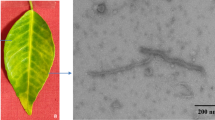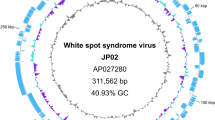Abstract
Recombination is one of the keys factor in evolutionary processes, involved in shaping the architecture of genomes and consequent phenotype. Understanding the recombination phenomenon especially among viruses will help in disease management. The present study aimed for in-silico analysis of recombination phenomenon among Begomoviruses, particularly emphasizing on viruses strains reported from India and neighboring countries. A total of 956 virus sequences have been used in this study. The Tomato yellow leaf curl China viruses, namely \(\hbox {gi}\vert 29825986\vert ;\hbox { gi}\vert 283468151\vert ; \hbox { gi}\vert 190559151\vert\) and \(\hbox {gi}\vert 61652782\vert\) were identified with the highest number of recombination event (1273). However, the Mung bean yellow mosaic India virus \((\hbox {gi}\vert 66351988\vert )\) was found to have 1170 recombination event. The phylogenic analysis among the highly recombinant sequences was carried to get an insight of the evolution among viral sequences in this class of plant viruses. The phylogenetic analysis revealed a pattern in diversity among these virus strains and a split tree analysis showed diversity in the range of 0.049128335–10.269852. This in silico analysis may pave way for a greater understanding of recombination phenomenon in geminiviruses and it might be helpful for strategic plant viral disease management.


Similar content being viewed by others
References
Duffy S, Holmes EC (2008) Phylogenetic evidence for rapid rates of molecular evolution in the single-stranded DNA begomovirus tomato yellow leaf curl virus. J Virol 82(2):957–965
Ge LM, Zhang JT, Zhou XP, Li HY (2007) Genetic structure and population variability of Tomato yellow leaf curl China virus. J Virol 81:5902–5907
Posada D, Crandall KA, Holmes EC (2002) Recombination in evolutionary genomics. Annu Rev Genet 36:75–97
Chare ER, Hollmes EC (2006) A phylogenetic survey of recombination frequency in plant RNA viruses. Arch Virol 151(5):933–946
Lefeuvre P, Lett JM, Varsani A, Martin DP (2009) Widely conserved recombination patterns among single-Stranded DNA viruses. J Virol 83(6):2697–2707
Fauquet CM, Stanley J (2003) Geminivirus classification and nomenclature: progress and problems. Ann Appl Biol 142:165–189
Moflat AS (1999) Plant pathology-geminiviruses emerge as serious crop threat. Science 286:1835
Bird J, Idris AM, Rogan D, Brown JA (2001) Introduction of the exotic tomato yellow leaf curl virus-Israel in tomato to Puerto Rico. plant Dis J 85:1028
Harrison BD, Robinson DJ (1999) Natural genomic and antigenic variation in whitefly-transmitted geminiviruses (Begomoviruses). Annu Rev Phytopathol 37:369–398
Fauquet CM, Sawyer S, Idris AM, Brown JK (2005) Sequence analysis and 6 classification of apparent recombinant begomoviruses infecting tomato in the Nile and Mediterranean basins. Phytopathology 95:549–555
García-Andrés S, Toma’s DM, Sánchez-Campos S, Navas-Castillo J, Moriones E (2007) Frequent occurrence of recombinants in mixed infections of tomato yellow leaf curl disease-associated begomoviruses. Virology 365:210–219
Bananej K, Kheyr-Pour A, Salekdeh GH, Ahoonmanesh A (2000) Complete nucleotide sequence of Iranian tomato yellow leaf curl virus isolate: further evidence for natural recombination amongst begomoviruses. Arch Virol 149:1435–1443
Monci F, Sa’nchez-Campos S, Navas-Castillo J, Moriones E (2002) A natural recombinant between the geminiviruses Tomato yellow leaf curl Sardinia virus and Tomato yellow leaf curl virus exhibits a novel pathogenic phenotype and is becoming prevalent in Spanish populations. Virology 303:317–326
Padidam M, Sawyer S, Fauquet CM (1999) Possible emergence of new geminivirus by frequent recombination. Virology 265:218–225. doi:10.1006/viro.1999.0056
Zhou X, Liu Y, Calvert L, Munoz C, Otim-Nape GW, Robinson DJ, Harrison BD (1997) Evidence that DNA-A of a geminivirus associated with severe cassava mosaic disease in Uganda has arisen by interspecific recombination. J Gen Virol 78:2101–2111
Fraile A, García-Arenal F (2010) The coevolution of plants and viruses: resistance and pathogenicity. Adv Virus Res 76:1–32
Morya VK, Yadav S, Kim EK, Yadav D (2012) In silico characterization of alkaline proteases from different species of Aspergillus. Appl Biochem Biotechnol 166(1):243–257
Tamura K, Dudley J, Nei M, Kumar S. (2007) MEGA4: Molecular Evolutionary Genetics Analysis (MEGA) software version 4.0
Martin DP, Williamson C, Posada D (2005) RDP2: recombination detection and analysis from sequence alignments. Bioinformatics 21(2):260–262
Felsenstein J (1989) PHYLIP manual, version 3.2. University of California Herbarium. Berkeley, California
Olsen GJ, Matsuda H, Hagstrom R, Overbeek R (1994) Fast DNA mL: a tool for construction of phylogenetic trees of DNA sequences using maximum likelihood. Comput Appl Biosci 10(1):41–48
Rohayem J, Münch J, Rethwilm A (2005) Evidence of recombination in the norovirus capsid gene. J Virol 79(8):4977–4990
Singh AK, Mahinghara BK, Hallan V, Ram R, Zaidi AA (2008) Recombination and phylogeographical analysis of Lily symptomless virus. Virus Genes 36(2):421–427
Posada D (2002) Evaluation of methods for detecting recombination from DNA sequences: empirical data. Mol Biol Evol 19(5):708–717
Posada D, Crandall KA (2001) Evaluation of methods for detecting recombination from DNA sequences: computer simulations. Proc Nat Acad Sci USA 98(24):13757–13762
Lewis-Rogers N, Crandall KA, Posada D (2004) Evolutionary analyses of genetic recombination. In: Parisi V, De Fonzo V, Aluffi-Pentini F (eds) Dynamical genetics. pp 49–78
Paplomatas EJ, Patel VP, Hou YM, Noueiry AO, Gilbertson RL (1994) Molecular characterization of a new saptransmissible bipartite genome geminivirus infecting tomatoes in Mexico. Phytopathology 84:1215–1224
Pita JS, Fondong VN, Sangare A, Otim-Nape GW, Ogwal S, Fauquet CM (2001) Recombination, pseudorecombination and synergism of geminiviruses are determinant keys to the epidemic of severe cassava mosaic disease in Uganda. J Gen Virol 82:655–665
Saunders K, Salim N, Mali VR, Malathi VG, Briddon R, Markham PG, Stanley J (2002) Characterization of Sri Lankan cassava mosaic virus and Indian cassava mosaic virus: evidence for acquisition of a DNA B component by a monopartite begomovirus. Virology 293(1):63–74
Unseld S, Ringel M, Höfer P, Höhnle M, Jeske H, Bedford ID, Markham PG, Frischmuth T (2000) Host range and symptom variation of pseudorecombinant virus produced by two distinct bipartite geminiviruses. Arch Virol 145:1449–1454
Seal SE, VandenBosch F, Jeger MJ (2006) Factors influencing begomovirus evolution and their increasing global significance: implications for sustainable control. Crit Rev Plant Sci 25:23–46
Van Den Bosch F, Akudibilah F, Seal S, Jeger M (2006) Host resistance and the evolutionary response of plant viruses. J Appl Ecol 43:506–516
Vadivukarasi T, Girish KR, Usha R (2006) Sequence and recombination analyses of the geminivirus replication initiator protein. J Biosci 32(1):17–29
Fondong VN, Pita JS, Rey MEC, de Kochko A, Beachy RN, Fauquet CM (2000) Evidence of synergism between African cassava mosaic virus and a new double-recombinant geminivirus infecting cassava in Cameroon. J Gen Virol 81:287–297
Prassana HC, Rai M (2007) Detection and frequency of recombination in tomato-infecting begomoviruses of South and Southeast Asia. Virol J 4:111
Howarth AJ, Vandemark GJ (1989) Phylogeny of geminiviruses. J Gen Virol 70:2717–2727
Harrison BD (1985) Advances in geminivirus research. Annu Rev Phytopathol 23:55–83
Hasiów-Jaroszewska B, Kuzniar A, Peters AS, Leunissen JAM, Pospieszny H (2010) Evidence for RNA recombination between distinct isolates of Pepino mosaic virus. Acta Biochim Pol 57(3):385–388
Holland JDE (1998) Origin and evolution of viruses. Virus Genes 16:13–41
Keese P, Gibbs A (1993) Plant viruses: master explorers of evolutionary space. Curr Opin Genet Dev 3:873–877
Acknowledgments
Authors V. K. Morya and Birendra K. Singh are thankful to Inha University, Incheon, South Korea; however, Yachna Singh and G. Thomas are thankful to Sam Higginbottom Institute of Agriculture, Technology and Sciences, Allahabad, India, for providing necessary environment.
Author information
Authors and Affiliations
Corresponding author
Rights and permissions
About this article
Cite this article
Morya, V.K., Singh, Y., Singh, B.K. et al. Ecogenomics of Geminivirus from India and Neighbor Countries: An In Silico Analysis of Recombination Phenomenon. Interdiscip Sci Comput Life Sci 7, 168–176 (2015). https://doi.org/10.1007/s12539-015-0020-3
Received:
Revised:
Accepted:
Published:
Issue Date:
DOI: https://doi.org/10.1007/s12539-015-0020-3




